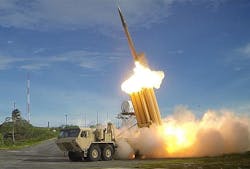Lockheed Martin to build additional anti-ballistic missile interceptors for missile defense
HUNTSVILLE, Ala. –Missile defense experts at Lockheed Martin Corp. will build additional anti-ballistic missile rocket interceptors to protect against incoming ballistic missile threats under terms of a nearly half-billion-dollar order announced Friday.
Officials of the U.S. Missile Defense Agency (MDA) in Huntsville, Ala., are awarding a $459.2 million contract modification to the Lockheed Martin Missiles and Fire Control segment in Dallas to build additional Lot 10 one-shot Terminal High Altitude Area Defense (THAAD) ballistic missile defense system interceptor missiles.
THAAD is designed to shoot down short-, medium-, and intermediate-range ballistic missiles in their terminal phase using a hit-to-kill kinetic warhead. The missile relies on the kinetic energy of the interception impact to destroy the incoming missile.
The system is a key element of the U.S. ballistic missile defense system to defend the continental United States, its deployed forces, friends, and allies against ballistic missiles of all ranges and in all phases of flight.
THAAD consists of five major components: launchers, interceptors, a radar, THAAD fire control and communications (TFCC) units, and THAAD-specific support equipment.
Lockheed Martin started developing the THAAD system in 1992, and first tested the system three years later. The first THAAD tests that hit their targets were in 1999, after the first six tests missed. THAAD missiles, which have a maximum range of about 125 miles, are expected to hit incoming ballistic missile warheads as high as 93 miles above the Earth's surface.
THAAD uses an X-Band radar from the Raytheon Co. Integrated Air Defense segment in Andover, Mass. Other key subcontractors are Boeing, Aerojet, Rocketdyne, Honeywell, BAE Systems, and Milton CAT.
This contract modification brings the value of this contract from $826.7 million to nearly $1.3 billion. Lockheed Martin will do the work in Dallas, Texas; Sunnyvale, Calif.; Huntsville, Anniston, and Troy, Ala.; and Camden, Ark., and should be finished by June 2021.
For more information contact Lockheed Martin Missiles and Fire Control online at www.lockheedmartin.com/us/mfc.html, or the Missile Defense Agency at www.mda.mil.
Ready to make a purchase? Search the Military & Aerospace Electronics Buyer's Guide for companies, new products, press releases, and videos

John Keller | Editor
John Keller is editor-in-chief of Military & Aerospace Electronics magazine, which provides extensive coverage and analysis of enabling electronic and optoelectronic technologies in military, space, and commercial aviation applications. A member of the Military & Aerospace Electronics staff since the magazine's founding in 1989, Mr. Keller took over as chief editor in 1995.

